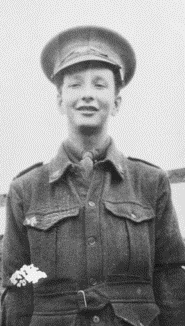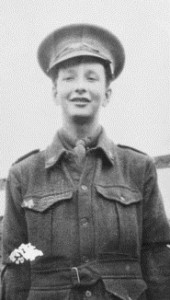Ernest Lachlan Powter was born in Orange on 9 March 1900, the second son of Jabez Langley Powter and Catherine Laurie Powter. In September 1915 Ernest was 15 years old and working as a junior clerk, when, claiming to be 18, he enlisted. Ernest is the youngest known recruit from Orange to enlist in WWI. Indeed, a fellow soldier described Ernest as “just a slight slip of a boy, with rather a girlish face.”
Private Powter embarked from Sydney with the 15th Reinforcements aboard HMAT Star of England on 8 March 1916. He transferred to the 53rd Battalion in Egypt the following month, where he served as a stretcher bearer. In June Ernest proceeded to France, where he continued his work as a stretcher bearer.
On 1 November 1916 in the field near Flers, Ernest suffered a gunshot wound to the left leg. There are conflicting reports regarding his fate. According to one comrade he was shot behind the left knee, requiring amputation of his leg, and he died following the operation. Another report claimed: “The wound did not appear to be very bad. There was much talk about the Blighty touch.”
It appears that Ernest was admitted to the 8th Australian Field Ambulance Station, but an entry on his casualty form dated 1 January 1917 states: “no further report of the man”. It was not until 21 March 1917 that Ernest was reported as having died of wounds received in action. Ernest’s father and stepmother were not advised of his death until April 1917, and his final resting place is not known.
Ernest’s name appears on the Australian War Memorial’s Boy Soldiers of WWI Honour Roll, and he is commemorated on the Villers-Bretonneux Memorial in France.
The following tribute appeared in the Sydney Morning Herald, 1 November 1917:
In loving memory of our dear son and brother, Private Ernest Powter, died of wounds in France, 1 November 1916. Inserted by his sorrowing father, stepmother, and only brother, Claude.
Ernie, how we pictured your safe returning,
And longed to clasp your loving hand.
The shock was great, the blow severe,
To part with one we loved so dear.
But we’ll meet in a better land.
Ernest’s older brother Claude Jabez Powter also served in WWI.
Ernest Lachlan Powter by Meg Vaughan, Ernest’s great niece.
During the simpler times of my childhood, Sundays were often reserved by families, for church and then the family Sunday lunch. And so it was for me, with my grandmother’s Sunday roast a ritual. When the family sat at her big dining table and feasted on lamb and roast veggies, we were always aware of the presence of an absent family member. On the wall, watching over the noisy proceedings, was a framed photo of two young men, one in military uniform. They were my grandmother, Annie-Laurie’s, two adored older brothers Claude and Ernie. The younger of the two staring proudly out at us was 15 year old Ernie on the eve of his departure to defend the Empire in the First World War. He was never to return and my grandmother’s heart was still filled with undiminished sadness.
The strength of this bond with her brother, shared with her surviving brother Claude, was born out of a difficult childhood that the three siblings endured by virtue of love and mutual support. As is often the case, it was loss that forged their bond. The children’s mother, Catherine, died before they had reached their teens. Their father soon remarried. Step-mother Edith was a strict Salvation Army devotee and quickly established a harsh and alienating regime for the children from which their ineffective father failed to protect them. This drew them even closer together, with elder brother Claude assuming the role of protector to Ernie and Annie-Laurie, a role he was to never relinquish. He and my grandmother remained very close throughout their lives and as such Uncle Claude would often be at the dining table with us on those Sundays, enhancing the atmosphere with his warmth and love.
It was not unusual on these occasions for my grandmother to re-tell the story of Uncle Ernie’s misadventure to the Western Front. In the telling, her grief was always palpable. She described how young Ernie, brimming with the enthusiasm of adventure and invincibility, had lied about his age and enlisted in the AIF at 15 and, as a stretcher-bearer, had tragically died only eight months later at Flers in France. Her story always left a strong impression on my young imagination as she expressed great pride in her young brother’s daring and courage mixed with the bitterness of the loss she still felt all these years later. In adulthood, I came to realise that Uncle Ernie’s story defined an important part of our family’s identity, that our family was, like 61,516 other Australian families during World War One, contributors of the ultimate gift to the nation.
My grandmother possessed a letter which was written by Uncle Ernie to her when he was in Egypt. I believe it to be the last letter he wrote. It was written on very fine white paper. He told her of the heat in Egypt and of his boredom waiting around with little to do. He said how he looked forward to leaving Egypt and being part of the action. He also related that he had visited a market and bought some trinkets for my grandmother. He told that he had sent these to her. He signed off that he loved her, his dear Laurie.
The quiet presence of Uncle Ernie’s story in my family’s life was much enlivened in April this year when out of the blue I was put in contact with Victor [Gordon]. We had a wonderful conversation as he told me of the genesis of the MEMORATE.COM.AU installation at the Orange Regional Gallery, and the central role that Uncle Ernie had been given as the exemplar of the Australian WW1 boy soldier. When he extended an invitation to me to attend the opening I felt at once privileged and humbled to be representing my family at such an unexpected honouring of my great uncle.
In the following days I wondered what the young Ernie would have thought of being remembered in such a meaningful way by the city of his birth. I thought, with some sadness and regret, of my grandmother Annie-Laurie, of Uncle Claude and my mother Gwenda, that they could not see this very public acknowledgement of the sacrifice that Ernie and ultimately they made.
Standing before Victor’s truly beautiful portrait of Ernie was so moving. Victor had captured his youth, his naivety, his optimism and the larrikin glint in his eye. He had brought this ordinary boy, a stretcher-bearer, my great uncle, to life again. Along with my reflections on my family’s history, MEMORATE’s powerful and incisive vision has caused me and no doubt many others, to contemplate the bleak industry of war. I am sure it will be an enduring and valuable endowment.
* Meg Vaughan, May 2015


